So you want to be a writer …
Last week Hanif Kureishi dismissed creative writing courses as 'a waste of time', yet they have never been more popular. Other leading author-teachers reveal their advice to students
Click here to read authors' 10 rules for writing
Click here to read authors' 10 rules for writing
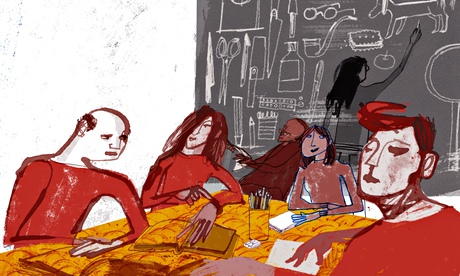
Illustration by Jill Calder
Philip Hensher
Good writing is a mixture of the calculated and the instinctual. No one writes through pure dazed inspiration; questions of craft and calculation enter in quite quickly. Last week, speaking at the Bath festival, Hanif Kureishi cast some doubt on the existence of transferable, teachable craft in writing by witheringly classifying 99.9% of his students as "untalented" and saying that writing a story is "a difficult thing to do and it's a great skill to have. Can you teach that? I don't think you can." (Kureishi teachescreative writing at Kingston University, apparently ineffectually).
What lies, or ought to lie, beneath the growth of creative writing as a subject is the conviction that a good deal of the best writing derives from conscious craft, if not all of it. Commentators sometimes say that writing can't be taught; that beginning writers either have "it", in which case they don't need to be taught, or they don't have "it", in which case money and time is being wasted by the exercise. But writers can perfectly well have native ability, a feel for language, an inventiveness and a keen eye towards the world and still not quite understand how they can do something well, not once, but repeatedly. A good creative writing course will explore underlying principles of good writing – not to impose invented "rules" on writing, but to introduce ways of thinking about writing that are strong and purposeful. You could teach yourself how to make a chair by taking a lot apart, and experimenting with joists. A furniture-making course might school you in some unsuspected skills, and save you some time.
A bad creative writing class will look like this. A student has submitted some work with the words: "I don't think it's very good." The class has (mostly) read it. After a long silence, one of the student's best friends, primed, says: "I really like the way you … " The student says: 'Thank you." Another one says: "I didn't quite understand about the bit where …" The student explains. Half the class stay silent; the student leaves with ego intact and work unimproved.
I've seen the experience of becoming a writer from both sides. When I began, it didn't occur to me to go on a creative writing course – there were few in the late 1980s, and it seemed more pressing to do an academic PhD. I taught myself to write. I still think, for a writer who is also an insatiable reader, there is a lot to be said for the self-taught route. But since 2005, I've started teaching creative writing in universities, and now teach at Bath Spa. When I look at my first novels, they seem to me to have no idea about some technical features of the novel. I don't think I really had a solid novelistic technique until I wrote my third or fourth novel, and in today's publishing world, that would be a serious disadvantage in a career.
 Illustration by Adam Gale
Illustration by Adam Gale
Creative writing, as a discipline, may not be entirely selfless, despite any beneficial results. It is no accident that it started expanding at precisely the moment when traditional financial props of the writers' trade such as the Net Book Agreement were abolished; when traditional supports of writers' incomes such as book reviews started being eroded by budget cuts; when publishers, under their own pressures, started savagely cutting away at their standard advances for authors of all levels. The days when VS Pritchett could run a house in a Regent's Park terrace on the proceeds from short stories and book reviews are long gone. In 2014, a professorial salary may be anything, financially, from a useful support to an absolute necessity.
Forced into the academy, a writer might run a good seminar something like this. We would probably talk about an exercise of street observation undertaken in the previous days – how people groom themselves, or attract the attention of strangers. We might discuss an aspect of technique with reference to a passage from a published piece of fiction – last week we talked about character from the outside, looking at a page ofElizabeth Bowen. We might look at a classic book, or an absolutely new novel – it's an obligation on a creative writing course to keep up with new work, and we're investing not just in new work, but in new digital techniques for writing.
Other ways of thinking about humanity might prove relevant. There are writers' statements or thoughts about what they do as writers – Arnold Bennett's glorious book on the subject, or Virginia Woolf's counter-statement about the exterior and interior world of the mind, or any number of interviews with present-day authors. Or we could have a look at sociologists' analysis, like that of Erving Goffman, or psychologists', or anything else that seems interesting and relevant. When student work is discussed, it has to be a safe but rigorous process. Constructive comments are insisted on; not ego-massaging niceness, but specific comments on where something has gone wrong and how it might be improved. The focus is on technique as well as emotion and experience. Is the presiding consciousness the right one? Does he need to filter everything through his awareness? Is this the right tense? What is this thing called free indirect style? Does enough happen? Do students say: "I really like the part where you …"? You bet your sweet bippy they don't.
Classes, at Bath Spa and elsewhere, differ greatly. With a faculty that includes very varied authors, there is never going to be a uniform approach. But we often find ourselves addressing recurrent issues. How can I create characters that are memorable and engaging? (Top tip – introduce them in small groups, and out of their customary context.) There doesn't seem to be enough happening – my characters just keep telling each other how they feel about each other, and then they have an affair or kill each other or have a baby. But then what? (Top tip; incident has to keep coming from outside, and the unexpected illuminates character. Try experimentally dropping a giant block of frozen piss through the ceiling of their room and see what they do.)
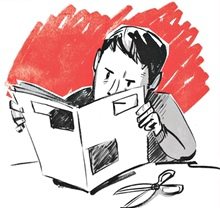 Illustration by Adam Gale
Illustration by Adam Gale
There are also possibilities that writers just haven't perceived. You don't have to present action as a one-off series of events; actions can be beautifully recurrent in a sentence running: "Whenever Amir visited Brenda, he always took the second-cheapest box of milk chocolates from the newsagents for her. She would always thank him effusively." You don't induce emotions by talking about those emotions; you are much more likely to do so by describing facts of the world, quite objectively. Go out into the street and watch human beings attentively; you will probably realise with a shock that your vocabulary of gestures – which now runs, in its entirety "he shrugged, she grinned, he frowned, she shook her head, he rolled his eyes, she sighed" – is totally inadequate. (And how rude and rare is shrugging, anyway?)
Personally, I like to irritate as well as inspire a class, sometimes by saying sagely: "A short story consists of an introduction, five OR seven episodes, and a coda in which the weather changes." (Worked for Chekhov, anyway.) Or: "If you're going to have an animal in a story, have a dog and not a cat." (Dogs are easier structural principles, running up to strangers in parks, and so on.)
Your students are not, thank heaven, going to be much like you as writers. They are going to react against you with their own thoughts and creative principles. Yes, there are courses where people who write present-tense historical novels, apparently about 21st-century women in a crinoline, produce students who do exactly the same thing. But a good creative writing course will produce independent-thinking, craftsmanlike innovators with critical, widely curious and energetic minds. I don't know why this goal isn't more common in universities, anyway.
Philip Hensher is a professor of creative writing at Bath Spa University.
Jeanette Winterson
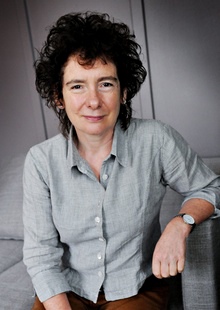 Jeanette Winterson. Photograph: IBL/REX
Jeanette Winterson. Photograph: IBL/REX
1) I don't give a shit what's in your head. By which I mean if it isn't on the page it doesn't exist. The connection between your mind and the reader's mind is language. Reading is not telepathy.
2) I don't care whether you like the texts we study or you don't. Like or dislike is a personal thing and tells me something about you, but nothing about the text. If you don't think something is well written, convince me. If you do think so, convince me. Learn from everything you read and understand how to learn from everything you read. And above all read! My classes use texts I am pretty sure they won't know because I want them to see how wide is the world of books and thought and imagination. I am trying to reposition them in relation to, in response to, language.
3) Writing is a love affair not a solitary pleasure. You can write about anything you like but there must be a connection between you and the material.
4) Do not take any "advice" on how to write from anyone who has not written and published a significant piece of work. (Ezra Pound was right.)
Jeanette Winterson is a professor of creative writing at Manchester University.
Rachel Cusk
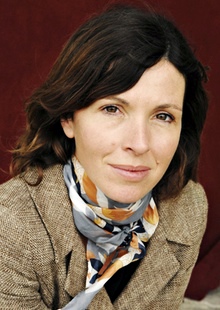 Rachel Cusk. Photograph: Ulf Andersen/Getty Images
Rachel Cusk. Photograph: Ulf Andersen/Getty Images
Many creative writing students start with the belief that writing is entirely the operation of point of view; in other words, that the world only exists in so far as it is perceived by a human personality. Most of what I teach involves encouraging students to exteriorise their subjective world by fixing it to objects, instead of routing everything through the persona of Jane or John. For the reader, being trapped in the head of Jane or John, and dependent on them for every scrap of information, is the precise opposite of their own experience of existence. A story that starts with "Jane looked out of the kitchen window and thought about her life" – despite the fact that it may be perfectly true – will always be struggling to free itself from a basic unreality.
Many students find this idea counterintuitive, but the easier and more effortless something looks, the more thoroughly it is underpinned by technique. The desire to write comes easily; writing itself is technical and hard. I give my students exercises in which a certain object has to feature. I choose the object myself: the more alien it is to their subjective processes the better. The object represents the impingement of reality, and it nearly always has the effect of turning their writing inside out. Over time I've learned which objects work the best: some of the things I've used – a violin, a pair of scissors – have been too easily conscripted into the student's subjective world. Others – a lawnmower, a new pair of shoes – unfailingly make the writing more objective. The narrative has to find a way around it, like water has to flow around an obstacle, and the result is that the whole enterprise is given form.
Rachel Cusk is professor of creative writing at Kingston University.
Michael Cunningham
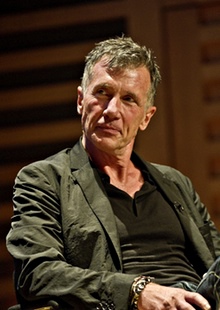 Michael Cunningham. Photograph: Sarah Lee for the Guardian
Michael Cunningham. Photograph: Sarah Lee for the Guardian
I teach a class on the craft of fiction-writing at Yale, which is a hybrid of a literature course and a writing workshop. If a more traditional literature course has to do with why we're interested in writers like Henry James and James Joyce, my class focuses on how they did what they did, using only ink, paper, and the same vocabulary available to everyone.
If a more traditional workshop is largely based on trial and error – write a story and we'll tell you what's wrong with it – my course is based at least partly on why writers write as they do; on the basis for their decisions.
I do remind my students, periodically, that fiction contains an element of ineluctable mystery along with its elements of craft, and that a great story or novel is great in certain ways we can elucidate, and certain ways in which we cannot. We don't dissect great literature in the belief that once all its organs are spread out on the table before us, we've got it figured out.
We read extensively and, each week, do our best to determine how certain effects were achieved by a different writer. How did James build his characters in The Aspern Papers? How did Joyce structure "The Dead"?
The students perform writing exercises as we go along. During the week we spend on character, for instance, I ask them to write a single paragraph that conveys the appearance and essential nature of a character. During the week on structure, I give them an impossible welter of information – seven different people, with twice that many interconnected dramas and conflicts – and ask them to sketch out a story, with the understanding that they can omit as much, or include as much, as they like.
During the final third of the semester I simply tell my students to take what they've learned, and write a story. Any story they like. Which can be anywhere from one to 25 pages long (though I encourage them to lean more toward single-digit page counts) – I stress economy and precision throughout the semester. The stories they come up with are often surprisingly good.
Michael Cunningham is a senior lecturer in creative writing at Yale University.
Tessa Hadley
 Illustration by Adam Gale
Illustration by Adam Gale
Last week we spent half an hour or more looking in minute detail at two versions of a paragraph from Jean Rhys's Wide Sargasso Sea. She seems to achieve the compression and electric intensity of her final version through minimising the connective engineering of the syntax in her sentences, taking out explanations, excising the mediating voice from around the things seen. The students went home to work on a paragraph of their own, cutting and intensifying in that way, taking out what's flabby and banal.
In the short-story class, we spent lots of time thinking about endings. Why do the endings of short stories carry so much more weight, in proportion to the whole, than the endings of novels? We wrangle over the endings of particular stories we've been reading together – Dubliners, Eudora Welty, Agnes Owens and others. What satisfies, what doesn't? How can the writer tell when it's enough? Why has taste turned against endings that clinch too tightly, or have too much twist in the tail? The students are working on their own stories: with that reading and discussion behind them they can think with more scope and more audacity about where to go, how to sign off. Rehearsing these things collectively loosens the tight fit of fear and inhibition, imagination relaxes.
The writing course offers an audience. Everyone lifts their game in response to the exacting readers they'll face next Tuesday. Student writers are under pressure to learn to hear themselves, to hear how they sound, to make essential judgments about tone and pace and transition. Of course, all writers have always had to learn this; a good writing course just crystallises the opportunity. In the past apprentice writers practised with a coterie of friends, or with their family, or with a mentor. Writing courses aren't free; but I'm sure they do help to widen the circle of opportunity, beyond the metropolitan and university cliques.
Tessa Hadley is a professor of creative writing at Bath Spa University.
Gary Shteyngart
It helps to be clean and presentable when teaching. Students react to sharp odours. It can't be like the University of Iowa during John Cheever's time when you could just wander in drunk and fall asleep for two hours. Today's MFA students expect you to be awake. I also try to get students to bring in snacks because I have low-blood sugar. But the snacks are really for everyone.
Gary Shteyngart is associate professor of creative writing at Columbia University.
Naomi Alderman
1) The most useful thing you can do is read someone's work and give them specific advice regarding what is and isn't working in their particular book. That is what goes on. It's the non-universal stuff that is the most useful. Are you using description to cover the fact that you don't really know your characters? Have you given your particular character a motivation that makes sense? It's not general, it's specific.
2) Another key thing you can help with is finding the writing routine that works best for each student. For me, when I'm working on a book, it's around 800 words a day every single day. Five hundred words a day is too few. A thousand is too many. I can't take the weekend off; if I do the book has dissolved to mush when I get back. So a teacher can talk to you about your process. Suggest different ways of working, different times, places, different rituals to get you in the right mental place for it. Again, this is very particular to the individual.
3) If you're a responsible teacher, you talk to your students about money. You say: most novelists earn around £5,000 a year from their writing. You watch them blench. You say: so if you're going to do this, you have to think about how you're going to support yourself. I tell my students about journalism, about other kinds of writing, about crowdfunding, about grants, about balancing the day job with the novels, and the pitfalls of all of these. Most people can't make a living only from selling their art, but almost anyone can put together a life in and around the artform they love if that's what they really want. You help them work out how to do that.
Naomi Alderman is a professor of creative writing at Bath Spa University.
Don Paterson
At St Andrews, we tend to teach that most problems writers encounter have already been solved by other writers: students learn to be good readers first. Often the most useful exercise is just to compare some bad writing with some good, and then learn how to articulate the difference between the two. This is most bracing when the bad writing is your own. Here's Robert Frost; here's you. What's the difference? Ouch. I teach in three ways: seminars on poetic composition (I take a fairly technical and linguistic approach, but not everyone does); workshops, where students can hone their editorial and critical skills; and one-to-one sessions, which address the very personal business of "art practice". There are many useful textbooks that can help with the first two, though very few of those are about "creative writing" (a term I try to avoid anyway). Almost no books I've read address "practice" very satisfactorily, though many students have benefited from reading (ex-marine!) Steven Pressfield's The War of Art, which is basically the Allen Carr method for writers: just do it already.
Don Paterson is a professor of poetry at the University of St Andrews.
Chang-Rae Lee
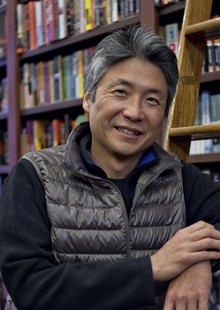 Chang-Rae Lee. Photograph: Tim Knox for the Guardian
Chang-Rae Lee. Photograph: Tim Knox for the Guardian
My classes are undergraduates only. Our primary activity in the workshop is to read very closely both the workshop material and a published story, which is assigned weekly. It's as simple as that. No use of "exercises" or discussion of "technique". While what the pieces might "mean" to us will no doubt arise, we first and foremost pay zealous attention to the words, going sentence by sentence, considering what's being instituted by each clause in every way possible (language, idea, structure, trope, tonality, perspective etc), appraising how the prose is developing its world and characters as well as shaping our apprehension of them.
Chang-Rae Lee is a professor of creative writing at Princeton University.
Kathryn Hughes
1) Lots of people can write beautiful prose, it's structure that's tricky. Novelists can afford to just start writing and see where it takes them, writers of non-fiction need to have a plan. Draw up a list of "landing places", points in your narrative where your reader can have a bit of a sit down and admire the view so far. Your job as narrator is to lead them from one landing place to the next, neither chivvying them along nor allowing them to lag behind. Make sure, though, that you don't come over like a drill sergeant. The trick of good narrative non-fiction is to allow the reader to feel that they have worked it all out for themselves.
2) Just because you are trying to learn how to write, it doesn't mean that you need to employ an entirely new vocabulary. Be ruthless about cutting out any word that you wouldn't use naturally in everyday speech. In real life no one calls a book "a tome" or says "she descended the stairs" or refers to "my companion". A book is a book, people walk down the stairs and a companion is actually a friend, or a lover, or a colleague or someone you were standing next to at the bus stop. Be specific and be real.
3) It is entirely normal – in fact, it is entirely right – to feel despair during the writing process. At some point in the relationship between a creative writing tutor and a student, there will be a conversation that runs exactly like the closing lines of Samuel Beckett's 1953 novel, The Unnamable:
You must go on.
I can't go on.
I'll go on.
When you hear these words coming out of your mouth, the best thing to do is shut up shop for the day and go and read someone who is writing the kind of stuff that you would like to. You'll start work the next day with a better pair of ears. And good ears, actually, are what good writing is all about.
Kathryn Hughes is director of UEA's MA programme in biography and creative non-fiction.
Toby Litt
 Illustration by Adam Gale Photograph: Adam Gale
Illustration by Adam Gale Photograph: Adam Gale
Although we give classes on the technical aspects of writing, one of the most important things we give is more basic. It's permission. Permission, for example, for a student on the MA to say, "I'm sorry, I really can't come out on Friday night – I have coursework." Because however supportive of a partner's or friend's or relative's ambition to become a writer people are, they often aren't very good at granting them the necessary time. And, for most of us, it's easier to say, "I have coursework" than "I'm writing a novel – it'll take me about five years, and might not get published."
We also give students permission to experiment, and encouragement to try things that they think might fail. Even quite late on in the course, when I'm advising students about what to write for their final dissertation, they will ask me, "Can I try this?" They know it's what they should do, they just need permission to do it. If they didn't have someone they respected (because that person is a tutor, because they've been published) to say this, they might never dare – and much of their best work wouldn't happen.
Finally, we – the teaching staff – give students permission to believe they might become "real" writers. Because, by being in the room with them, week after week, we help demystify what "real" writers are. Too many people write badly because they write up to their idea of what "real" writing should be or what a "real" writer should write. They put on literary airs. If someone holds writers in too much esteem, they'll never become one.
Toby Litt is a senior lecturer in creative writing at Birkbeck University of London.
Joyce Carol Oates
Students in graduate writing programmes are already seriously committed writers by the time they enrol for a workshop; prospective students must apply, and only a small number are selected. Certainly in the US, many, or most, have already published short fiction. No one "teaches" young people how to write in fiction workshops; the classes might be described as intensely focused editing sessions in which manuscripts of substance are examined with the close scrutiny with which they would be examined by editors at such magazines as the New Yorker and Harpers, or in such literary publishing houses as Ecco/HarperCollins and Farrar, Strauss & Giroux.
Joyce Carol Oates is a professor of creative writing at Princeton University.
Curtis Sittenfeld
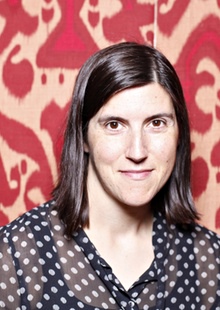 Curtis Sittenfeld. Photograph: Katherine Rose for the Guardian
Curtis Sittenfeld. Photograph: Katherine Rose for the Guardian
Establish a writing schedule ahead of time for the coming week or month. This is more important the less time you have. If you work full-time, you might plan to write for an hour at 6am on Tuesday and Thursday, or at 4pm on Wednesday and Saturday. Write this commitment down in your diary or calendar, don't schedule anything that conflicts with it, and sit alone somewhere you can focus when the time comes. It's OK if you don't produce sentences during that time, but don't do anything else – don't check email, don't text, don't go online (and for heaven's sake, if you're using a computer, shut all files and windows except for the one you're working on). If some nagging errand you need to do occurs to you, write it down, but don't start doing it.
Create an outline. This will give you a roadmap to follow and make you less likely to write yourself into a corner. It's fine to deviate from the outline, but it's very useful to think about the overall structure of what you're trying to produce. Similarly, don't go back and revise until you've completed a first draft. Solutions to problems tend to reveal themselves much more clearly when the whole work is finished than they do along the way.
If you don't enjoy the process of writing in some way, you probably shouldn't do it. While there are people who make lots of money from books, most don't, and many writers I know have found the experience of having a first (or subsequent) book published disappointing and anticlimactic. I agree with some of what I understand to be Hanif Kureishi's viewpoint, but I don't think anyone knows who does or doesn't have talent without that person giving writing a try.
Curtis Sittenfeld has taught creative writing at the Iowa Writers' Workshop, Victoria University in New Zealand, and St Albans School in Washington.
Blake Morrison
On the MA at Goldsmiths, I work individually with students in a range of forms (novels, short stories, poetry, non-fiction) but also run a specialist seminar in life writing. One key strand of the seminar is memoir, and among the exercises we've done this term are:
1) Restricted point of view. Recounting an episode from the perspective of someone whose eyes are sharp but whose capacity for understanding is limited. There's a wonderful example of this in Seamus Deane's Reading in the Dark, where a small boy recounts a traumatic episode (his dying sister being taken from the house by ambulance-men) while hiding under a table – all is revealed by what he observes in the movement and appearance of adult feet.
2) Bearing witness. Working in pairs, student A speaks of an episode he or she witnessed, and student B writes it up, selecting, exaggerating or even inventing key details – an exercise in how to create authenticity and demonstrate "I was there". Orwell's essay "A Hanging" offers a brilliant precedent, as does the first chapter of Tim Lott's The Scent of Dried Roses, which reconstructs the day of his mother's suicide.
3) Narrative pace. Forget what creative-writing handbooks say: narratives can't be all showing and no telling. A 10-minute scene that runs to 50 pages might be followed by a paragraph encapsulating two years. Lorna Sage's Bad Blood, Tobias Wolff's This Boy's Life and Martin Amis'sExperience are bold and inventive in the way they vary pace, and I encourage students to do the same.
All such workshop exercises have the same end in sight – to help aspirant writers find the right form for the story they want to tell. The luckiest go on to publish and win acclaim – two of our former students (Ross Raisin and Evie Wyld) made Granta's recent list of the 20 best young British novelists. But even those who don't win prizes or publishing contracts usually benefit from the course, by articulating their ideas and experiences, and by putting writing at the centre of their lives.
Blake Morrison is a professor of creative and life writing at Goldsmiths, University of London.
